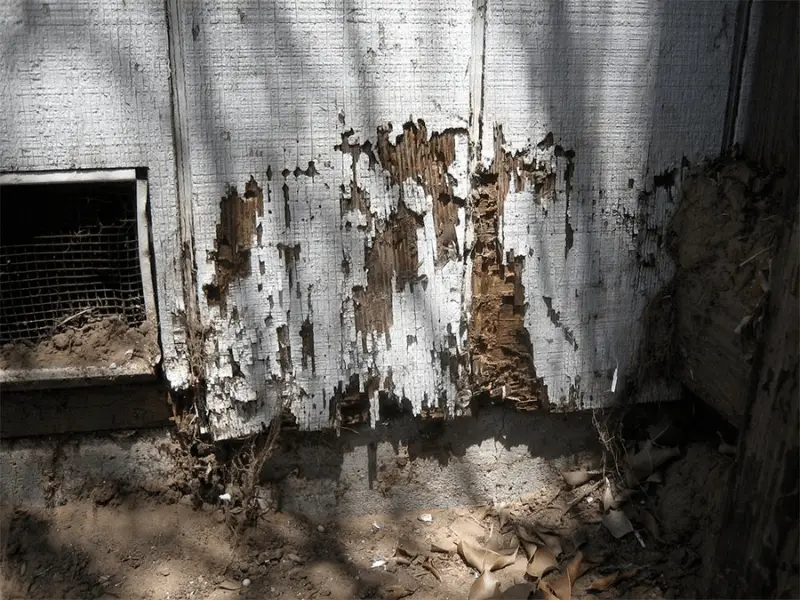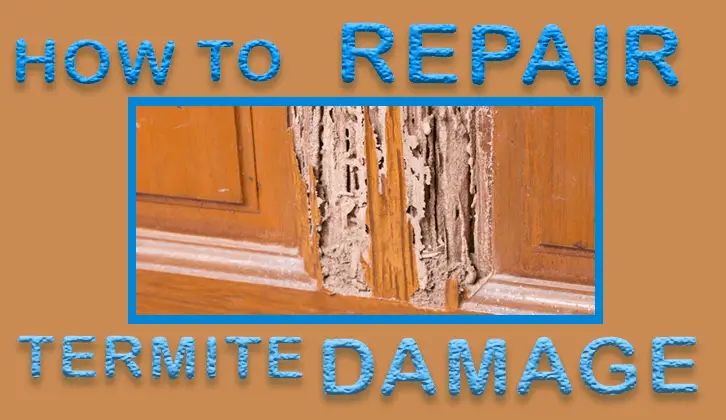Termites are a kind of bug that can seriously harm the structure of your house. They consume wood and other cellulose-based materials as food, and because they can go unnoticed for a long time, they can cause a great deal of harm if left untreated. They can get inside your house through tiny gaps and foundational faults. Regularly checking your home for termite damage indicators, such as soft or hollow-sounding wood, can help you spot an infestation early and avoid expensive structural damage.
Infestations can be avoided by keeping your home dry, clean, and uncluttered. Regularly checking your home for pest infestation indications will help you identify and address the issue quickly, avoiding costly structural damage and even health problems. To help you solve the issue and avoid more infestations, it’s crucial to get in touch with a pest control specialist as soon as you notice a pest infestation in your home.
Early Signs of Termite Damage

- Hollow parts in walls and floors.
- Holes on wooden surfaces.
- Clicking sounds are made by termites when they feed or alert others in times of danger.
- Termite tunnels are made around your homestead.
- Presence of termite swarms.
- Buckling ceilings or wood surfaces.
- Tight door jams and windows.
Can you fix Termite Damage?
Yes, you can repair all types of termite damage. But before you start repairing the damages, you will have to eradicate the termite infestation by treating them. Once you have managed to put them under control, you can now go ahead and work on the damages. Let’s now look at how to repair termite damage.
How to repair termite damage |Identify and get Rid off
How to Repair Termite Damage
There are several ways of fixing termite destruction, and they include:
1. Extensive Termite Treatment
Though you can work on termite damage yourself, it is always advisable that you call a professional exterminator who will deal with a termite infestation easily. This will ensure minimal chances of future termite infestation and that your results after repair will be excellent.
2. Replace Damaged sections
Sometimes you may encounter damages that are beyond repair. At this point, you cannot do anything else except replace the damaged Wood with another piece of Wood. Before you start replacing the Wood, it is always advisable that you hire an expert who will recommend suitable repairs for your house and help replace a larger portion of the damaged section.
3. Support the Damaged Sections With other wood Pieces
It is a method you use in minor termite damages. In the cases where you notice the presence of termites early enough, you can get rid of them and add wooden support beams or adjustments that will help strengthen the damaged section.
4. Use of Hardening Treatments
Sometimes, professional exterminators may recommend that you use hardening treatment to clear the damage. In such cases, Demon Max insecticide is always recommended as it gives total wood protection.
5. Use of Wood Fillers
Wood fillers are used in repairing extensive termite channels in the Wood. You can use them to fill the gap left by the termite since they look like wood putty. Before applying wood filler to the Wood, you need to prepare the damaged surface by cleaning or sanding it.
6. Use of Wood Hardeners
Wood hardeners are used in filling small gaps in woods that termites cause. For efficient results, you must select a wood hardener depending on the type of Wood and the level of damage.
Read Next
- How to Repair Rotting Wood
- Best Wood for Outdoor Use
- How to Treat Wood for Outdoor Use
- How to Keep Wood from Splitting
- Best Wood Glue for Outdoors
- Strongest Method for Joining Wood
How To Prevent Future Termite Damages
Because termite infestation is always unpredictable, you have to take proper measures to ensure that you curb them for good. Shown below are ways you can use to prevent future termite infestation.
- Introduce nematodes to your soil.
- Set out termite baits.
- Keep your house well-ventilated and maintain good moisture control.
- Spray boric acid and termiticidal repellents around your foundations and woods frequently.
- Create barriers between soil and your foundation.
- Call licensed termite professionals to inspect your homestead regularly.
Common Types of Termites
There are three distinct species of most destructive termites, and they include;
1. Dampwood Termites
Also called rotten wood termite. They get their name from damp and Wood decay, and they live in moist Wood or wet climate areas such as homes surrounded by dead trees, rotting stumps, or piles of firewood.
2. Drywood termites
They are a species of termites that live in dry Wood and small colonies. They have a small body, brown in colour, and consist of a queen who lays eggs, a king, and workers who eat and damage homes, fences, and trees.
3.Subterranean Termites
They are one of the most common species of termites in the world. They consist of reproductives and millions of workers and soldiers. In most cases, subterranean termites make complex interconnecting pathways to access food in their colonies.
In most cases, most termites make their way into the carpets, walls, trees, or furniture and live in dark, protected areas. Although not easily detected, shown below are visible signs of termite infestation in an area.
Visible signs of Termite Infestation
1. Swarmers
They are young male and female winged termites who mate to produce other groups of termites. Mostly, termites swarm during the day in search of new locations to start a colony. The act always provides a good opportunity for you to detect the presence of termites on your homestead.
2. Hard to open doors and windows
Termites tend to create a high-humidity environment inside their tunnels, making the wood surfaces warp easily. They also cause cracks in the shafts and door jams, making it hard to open and close doors or windows.
3. Termite droppings
Also known as frass or termite excrement. It is one of the most visible signs that indicate the presence of termites on your homestead. As termites feed on Wood, they excrete and later create holes to remove the pellets from their nests. Slowly, the droppings accumulate, forming visible piles.
4. Damaged Wood
Though one of the most difficult ways to determine termite infestation, it is still a sign to consider while inspecting termites in your home. Termites dig holes into woods searching for food and shelter, so when you fail to inspect your windows, doors, shelves, and roofs, they will cause extensive damage to your property.
5. Clicking sounds
It is another excellent way of detecting the presence of termites on your homestead. Termites bang their heads continuously against the Wood to alert others of the awaiting danger. The chewing of Wood by the worker termites also makes that distinctive clicking sound.
6. Papery Timber
Have you ever knocked or tapped a piece of Wood and then received a hollow sound? It might be an indication that termites reside there. As termites burrow and feed on the inside part of the timber, it becomes hollow, and later it starts cracking. If it is not prevented early, it greatly affects your home structure or even your reputation.
7. Uneven paints
Although painted wood surfaces are known to be harmful to termites because they do not contain the moisture required for their survival, it should not be a reason for you not to inspect your stained wooden objects. In some cases, termites infest such woods by consuming them directly behind the paint, making them crack, bubble or peel.
Check: How to Paint the Wood.
8. Galleries in Wood
They are known as tunnels or mud tubes. Though not easily noticed, it is one of the signs that can help you detect termite infestation in your homestead. Those termites mostly form tunnels to connect them to their food sources.
Bearing in mind that termites are small, destructive insects that can cause extensive property damage, it is always an excellent idea to get rid of them whenever you detect their presence.
Best-Known Ways Used in getting rid of termite infestations
1. Introduce Nematodes in Your Homestead
Nematodes are tiny worms that feed on termites until they are all gone. When you feel like termites are destroying your property, you can buy the worms and introduce them to the affected area.
2. Use of Borates
Despite borax powder being a washing detergent, It is also used in killing termites. You can choose to sprinkle the powder around the infested area or mix it with water before sprinkling.
3. Use of sunlight
The method only applies to dry wood termites. When you realize termites have infested your wood objects, take them out into the yard on a hot sunny day, and they will disappear.
4. Use of orange oil
Having been made of d-limonene and other components, orange oil is among the best methods of eliminating termites. After applying the oil to the affected areas, it dissolves the exoskeletons of termites, causing them to die after a short period. Spray your home regularly with orange oil to keep it free from termites.
5. Contact an expert
As most people do not know how to get rid of termite infestation, you are advised to seek the help of a professional terminator the moment you notice colonies of termites in your home. The terminators use liquid pesticides and DIY termite treatments to remove the termites.
6. Take preventive Measures
Instead of waiting for termites to infest, you can choose to prevent the problem. There are many ways of keeping termites away from your home, and they include.
Ways of Preventing Termite Infestations
1. Inspection
Lack of home inspection is one of the reasons why termites infest a place. To prevent termites from eating and destroying your property, you need to conduct regular inspections.
2. Avoid Garden Beds
Many people often use it as a ground cover for flower beds and kitchen gardens, but they fail to realize that termites are always attracted to moist and humid environments. If you want to prevent termites from infesting your homestead, you should do away with kitchen gardens and flower beds near your house.
3. Spray Borate on Wood Before Painting.
Spraying borate around the Wood before painting is one of the methods used in preventing termite infestation. The borate soaks deep into the furniture, doors, and window frames, preventing termites from destroying them.
4. Repair rotted Roofs
Before considering different termite control methods, you should first remove any unwanted timber or debris away from your house that may act as a source of food and a nesting site for termites.
Final thought
After eliminating termite infestation from your home, you do not have any other choice rather but to repair the damage they caused.
In most cases, the damage caused affects the structural image of the house or the wood object; hence it is necessary to deal with the situation as soon as possible.

There are a lot of termites in my house, and that is why I would like to look for a pest control service that will be able to address this matter. Thank you for sharing here as well that a wooden support beam may help get rid of those pests. Anyhow, I also appreciate your suggestion of keeping the proper moist-free.
Thanks.|
I never knew that termites are small insects that could sneak inside your property and damage your wooden furniture if left unattended. My colleague recently saw a couple of tiny insect wings around his wooden figure collection. Maybe he should look at this article and consider finding a termite control expert whenever needed.